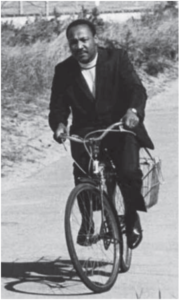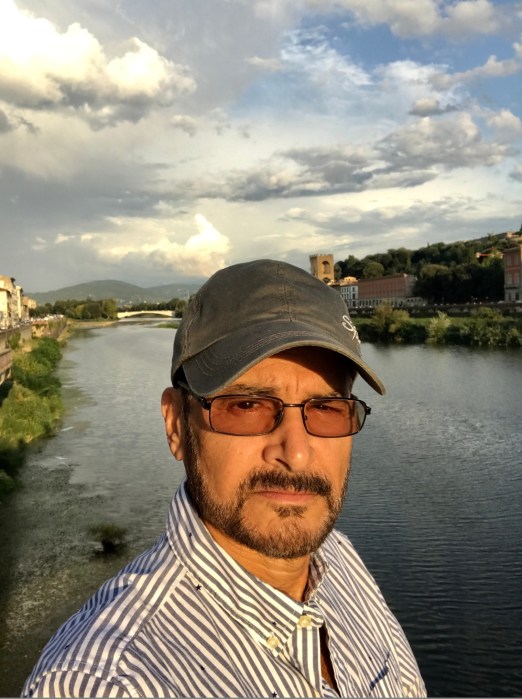By Thomas McGannFifty years ago, on Sept. 2, 1967, Nobel Peace Prize recipient Dr. Martin Luther King Jr. was the guest of honor at a fundraiser in Seaview, Fire Island. Despite the fact that the summer of ‘67 was called “the Summer of Love,” the country was in the midst of political and cultural turmoil. While Scott Mackenzie was singing “San Francisco (Be Sure to Wear Flowers in Your Hair),” Dr. King was engaged in a fight for the civil rights of African-Americans. For those too young to remember, this will just be a synoptic history lesson. For those who lived it, it remains all too real.Dr. King started early. In 1956, less than six months after receiving his Ph.D. in Theology, he led the Montgomery Bus Boycott. It was in response to Rosa Parks’ arrest for failure to give up her seat on a city bus to a white man. The resultant publicity catapulted him to the leadership of the civil rights movement. Dr. King adopted a policy of non-violent civil disobedience, based on the philosophy of Henry David Thoreau (a FI visitor himself) and Mahatma Gandhi. He led demonstrations, sitins, and voter registration drives to call attention to the plight of African-Americans.On Aug. 28, 1963, Dr. King led the historic March on Washington, attended by an estimated 250,000 people. The event culminated in his “I Have a Dream” speech, heralded as among the finest in American history.A scant three months later, President John F. Kennedy, a fierce warrior for civil rights, was assassinated. The new President, Lyndon Johnson, called upon Congress for passage of the Civil Rights Act of 1964 to honor Kennedy’s memory. But it was not going to be quite that easy, as a tumultuous battle for passage of the bill was underway in both houses of Congress. Dr. King had swayed public opinion in favor of the act, and that, coupled with sentiment for the recently slain JFK, finally facilitated passage of the bill.In recognition of the magnitude of his achievements, Dr. King was presented with the Nobel Peace Prize. In his acceptance speech he spoke about the power of non-violence – even in the face of violence.Dr. King decided to expand his mission to include ending the war in Vietnam, much to the chagrin of some of his most ardent supporters. He also promoted open housing, and organized a Poor People’s Campaign for economic justice.In response to acts of violence against those attempting to register voters – both black and white activists had been murdered – demonstrators marched from Selma, Alabama, to its capital Montgomery in March of 1965, where Dr. King delivered his “How Long Not Long” speech affirming that equal rights were close “because the arc of the moral universe is long, but it bends toward justice.”Then on Sept. 2, 1967, while most Fire Islanders were going about their business unaware of history in the making, Dr. King arrived on Fire Island as a guest of John Morrin. At a rally in Seaview, Dr. King spoke about community, the war in Vietnam, anti-Semitism and the need for a third political party. After the rally a cocktail party was held in Ocean Bay Park, at the home of Mr. and Mrs. Hyman Abbott, where $4,000 was raised ($30,000 in today’s money).In spite of the fact that posters had been torn down throughout the community, the gathering was still attended by more than 1,500 people. It elicited responses from the predominantly white audience such as, “tell them, brother, tell them.” Authors Herman Wouk and Bel Kaufman were in attendance, and both expressed enthusiasm about hearing the civil rights leader speak, but were dismayed regarding the poor reception from some residents. Kaufman was quoted in The New York Times on Sept. 4, 1967, saying, “The people you would like to reach are never the ones who show up at meetings.”Michael Abbott of Ocean Bay Park remembers that Dr. King spoke to a large crowd of people gathered on the beach at K Street in Seaview and later attended the fund-raising cocktail party for the Southern Christian Leadership Conference. Dr. King spent the night at the Abbott home, and Michael, age 13 at the time, had breakfast with him the following morning.
Despite the fact that the summer of ‘67 was called “the Summer of Love,” the country was in the midst of political and cultural turmoil. While Scott Mackenzie was singing “San Francisco (Be Sure to Wear Flowers in Your Hair),” Dr. King was engaged in a fight for the civil rights of African-Americans. For those too young to remember, this will just be a synoptic history lesson. For those who lived it, it remains all too real.Dr. King started early. In 1956, less than six months after receiving his Ph.D. in Theology, he led the Montgomery Bus Boycott. It was in response to Rosa Parks’ arrest for failure to give up her seat on a city bus to a white man. The resultant publicity catapulted him to the leadership of the civil rights movement. Dr. King adopted a policy of non-violent civil disobedience, based on the philosophy of Henry David Thoreau (a FI visitor himself) and Mahatma Gandhi. He led demonstrations, sitins, and voter registration drives to call attention to the plight of African-Americans.On Aug. 28, 1963, Dr. King led the historic March on Washington, attended by an estimated 250,000 people. The event culminated in his “I Have a Dream” speech, heralded as among the finest in American history.A scant three months later, President John F. Kennedy, a fierce warrior for civil rights, was assassinated. The new President, Lyndon Johnson, called upon Congress for passage of the Civil Rights Act of 1964 to honor Kennedy’s memory. But it was not going to be quite that easy, as a tumultuous battle for passage of the bill was underway in both houses of Congress. Dr. King had swayed public opinion in favor of the act, and that, coupled with sentiment for the recently slain JFK, finally facilitated passage of the bill.In recognition of the magnitude of his achievements, Dr. King was presented with the Nobel Peace Prize. In his acceptance speech he spoke about the power of non-violence – even in the face of violence.Dr. King decided to expand his mission to include ending the war in Vietnam, much to the chagrin of some of his most ardent supporters. He also promoted open housing, and organized a Poor People’s Campaign for economic justice.In response to acts of violence against those attempting to register voters – both black and white activists had been murdered – demonstrators marched from Selma, Alabama, to its capital Montgomery in March of 1965, where Dr. King delivered his “How Long Not Long” speech affirming that equal rights were close “because the arc of the moral universe is long, but it bends toward justice.”Then on Sept. 2, 1967, while most Fire Islanders were going about their business unaware of history in the making, Dr. King arrived on Fire Island as a guest of John Morrin. At a rally in Seaview, Dr. King spoke about community, the war in Vietnam, anti-Semitism and the need for a third political party. After the rally a cocktail party was held in Ocean Bay Park, at the home of Mr. and Mrs. Hyman Abbott, where $4,000 was raised ($30,000 in today’s money).In spite of the fact that posters had been torn down throughout the community, the gathering was still attended by more than 1,500 people. It elicited responses from the predominantly white audience such as, “tell them, brother, tell them.” Authors Herman Wouk and Bel Kaufman were in attendance, and both expressed enthusiasm about hearing the civil rights leader speak, but were dismayed regarding the poor reception from some residents. Kaufman was quoted in The New York Times on Sept. 4, 1967, saying, “The people you would like to reach are never the ones who show up at meetings.”Michael Abbott of Ocean Bay Park remembers that Dr. King spoke to a large crowd of people gathered on the beach at K Street in Seaview and later attended the fund-raising cocktail party for the Southern Christian Leadership Conference. Dr. King spent the night at the Abbott home, and Michael, age 13 at the time, had breakfast with him the following morning. Two photographs documenting Dr. King’s visit to Fire Island are often re-circulated on social media, but many do not know the origin of these iconic images. The popular photographs were taken by Newsday staff photographer Stan Wolfson. Hired by Newsday in 1966, Wolfson was at the very beginning of his career when he captured these wonderful moments. He would go on to have a very successful career with Newsday. Photographs he snapped of David Berkowitz a decade later being escorted by NYPD officers shortly after being arrested for the infamous “Son of Sam” murders in 1977, became famous too. Wolfson is still alive, and retired from Newsday in 2004. He did not return our calls for comment on this article.Shortly after visiting Fire Island, Dr. King, visiting Memphis, Tennessee, in support of black sanitation workers, delivered his “I’ve Been to the Mountaintop” speech in which he addressed the numerous death threats he had been receiving.Dr. King was assassinated the following day.As an interesting historical aside, this little spit of land, Fire Island, has hosted two Nobel Peace Prize recipients. Both Dr. Martin Luther King Jr. and General George C. Marshall have tread its sandy shores. Not many locales can claim such an honor.
Two photographs documenting Dr. King’s visit to Fire Island are often re-circulated on social media, but many do not know the origin of these iconic images. The popular photographs were taken by Newsday staff photographer Stan Wolfson. Hired by Newsday in 1966, Wolfson was at the very beginning of his career when he captured these wonderful moments. He would go on to have a very successful career with Newsday. Photographs he snapped of David Berkowitz a decade later being escorted by NYPD officers shortly after being arrested for the infamous “Son of Sam” murders in 1977, became famous too. Wolfson is still alive, and retired from Newsday in 2004. He did not return our calls for comment on this article.Shortly after visiting Fire Island, Dr. King, visiting Memphis, Tennessee, in support of black sanitation workers, delivered his “I’ve Been to the Mountaintop” speech in which he addressed the numerous death threats he had been receiving.Dr. King was assassinated the following day.As an interesting historical aside, this little spit of land, Fire Island, has hosted two Nobel Peace Prize recipients. Both Dr. Martin Luther King Jr. and General George C. Marshall have tread its sandy shores. Not many locales can claim such an honor.































